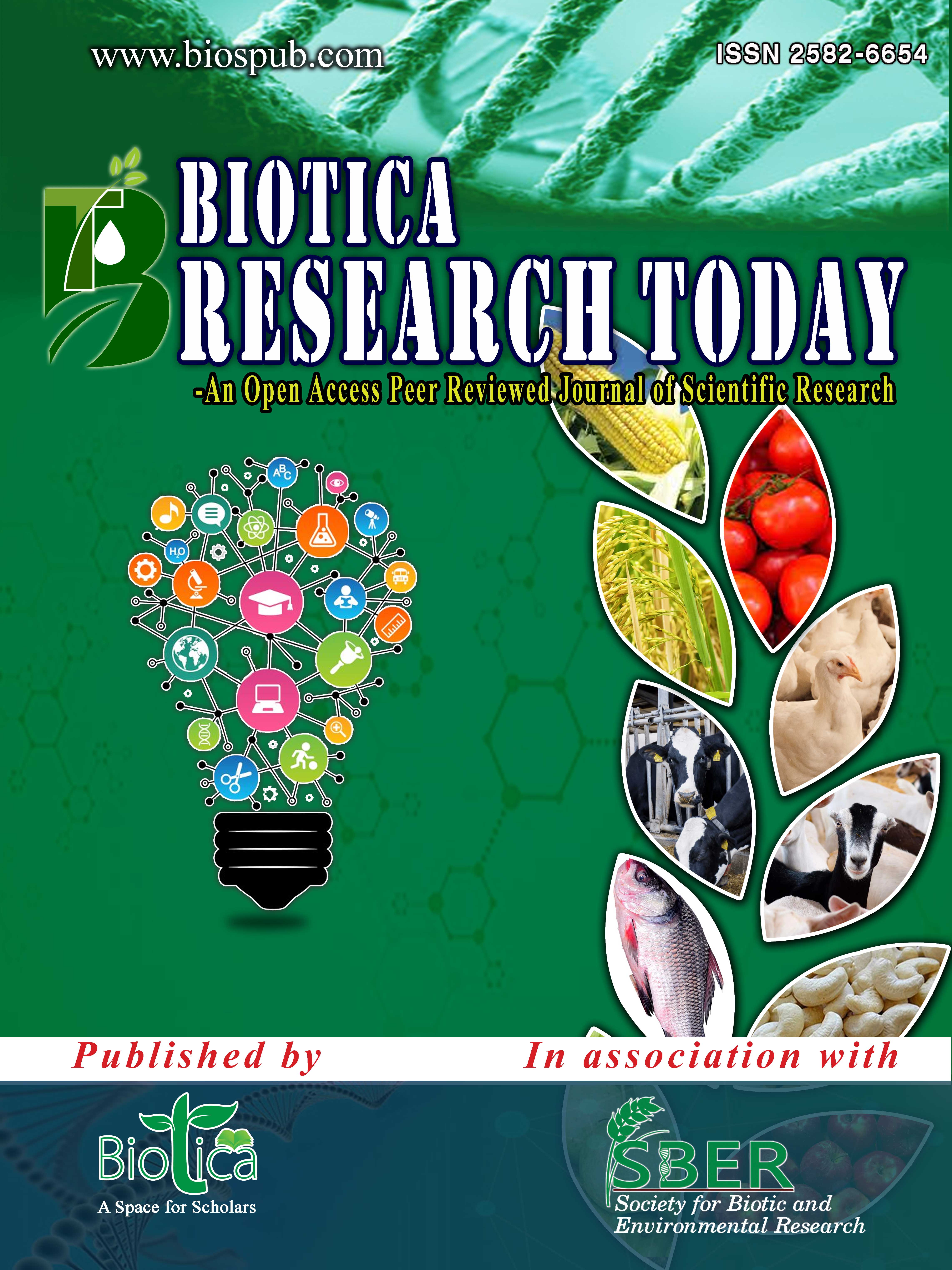Feeding and Reproductive Ecology of Rodents: A Review
DOI:
https://doi.org/10.54083/ResBio/6.1.2024/01-06Keywords:
Feeding ecology, Pest management, Reproductive ecology, Rodents, Vertebrate pestAbstract
Rodents are the most populous and widespread vertebrate pest of agriculture. It is a major cause of crop losses in fields and storage grains resulting in huge economic losses annually. Despite its huge economic importance, little is known about the pest in terms of its habitat, feeding habits, reproduction patterns and population dynamics. Due to the lack of proper knowledge, rodents are one of the most difficult pests to control in the agro-ecosystems. The management practices that exist are mostly chemo-centric and are often unreliable in controlling the populations. Hence, to develop efficient management strategies, it is important to gain a better insight into the ecology of rodents, both feeding and reproductive. This paper attempts to discuss the feeding and reproductive ecology of rodents, specifically but not limited to the agro-ecosystem.
Downloads
References
Ahsan, M.M., 2022. Study on diversity of Rodents (Mammalia: Rodentia) in and around Achalpur City, District Amravati, Maharashtra, India. International Journal of Scientific Research in Biological Sciences 9(1), 35-38.
Andreassen, H.P., Sundell, J., Ecke, F., Halle, S., Haapakoski, M., Henttonen, H., Huitu, O., Jacob, J., Johnsen, K., Koskela, E., Luque-Larena, J.J., Lecomte, N., Leirs, H., Mariën, J., Neby, M., Rätti, O., Sievert, T., Singleton, G.R., van Cann, J., Broecke, B.V., Ylönen, H., 2021. Population cycles and outbreaks of small rodents: Ten essential questions we still need to solve. Oecologia 195, 601-622. DOI: https://doi.org/10.1007/s00442-020-04810-w.
Andersson, M., Jonasson, S., 1986. Rodent cycles in relation to food resources on an alpine heath. Oikos 46(1), 93-106. DOI: https://doi.org/10.2307/3565385.
Aplin, K.P., Lalsiamliana, J., 2010. Chronical and impacts of the 2005-09 mautam in Mizoram. In: Rodent Outbreaks: Ecology and Impacts. (Eds.) Singleton, G.R., Belmain, S.R., Brown, P.R. and Hardy, B. International Rice Research Institute, Los Banos, Phillipines. pp. 13-47.
Belmain, S.R., Chakma, N., Sarker, N.J., Sarker, S.U., Sarker, S.K., Kamal, N.Q., 2010. The Chittagong story: Studies on the ecology of rat floods and bamboo masting. In: Rodent Outbreaks: Ecology and Impacts. (Eds.) Singleton, G.R., Belmain, S.R., Brown, P.R. and Hardy, B. International Rice Research Institute, Los Banos, Phillipines. pp. 49-64.
Borah, R.K., 2021. Damage by Rodent in Rice-Green gram cropping system in Brahmaputra Valley Zone. Annals of Plant Protection Sciences 29(2), 156-158. DOI: https://doi.org/10.5958/0974-0163.2021.00032.X.
Borah, R.K., 2016. Rodent incidence in Rice-Toria cropping system. Annals of Plant Protection Sciences 24(2), 373-375.
Burgin, C.J., Colella, J.P., Kahn, P.L., Upham, N.S., 2018. How many species of mammals are there? Journal of Mammalogy 99, 1-14. DOI: https://doi.org/10.1093/jmammal/gyx147.
Brotodjojo, R.R.R., Suprihanti, A., Wirawati, T., 2023. Population dynamics of rats (Rattus Argentiventer) in rice fields with different cropping systems. Transactions of the Chinese Society of Agricultural Machinery 54(6), 190-198.
Cao, D., Pimentel, D., Hart, K., 2002. Post harvest crop losses (insects and mites). In: Encyclopedia of Pest Management. (Ed.) Pimentel, D. Marcel Dekker, New York. pp. 723-730. DOI: https://doi.org/10.1201/NOE0824706326.
Colombe, S., Jancloes, M., Riviere, A., Bertherat, E., 2019. A new approach to rodent control to better protect human health: First international meeting of experts under the auspices of WHO and the Pan American Health Organization. Weekly Epidemiological Record 94(17), 197-203.
Chauhan, N.P.S., 2003. Observations of bamboo flowering and associated increases in rodent populations in the north-eastern region of India. In: Rats, Mice and People: Rodent Biology and Management. (Eds.) Singleton, G.R., Hinds, L.A., Krebs, C.J. and Spratt, D.M. ACIAR Monograph Series No. 96. Australian Centre for International Agricultural Research, Canberra, Australia. pp. 267-270.
Elango, K., Vijayalakshmi, G., Arunkumar, P., Sujithra, P., Sobhana, E., 2022. Indian scenario of non-insect pests affecting agricultural crops - An overview. Journal of Entomological Research 46(Suppl.), 1194-1204. DOI: https://doi.org/10.5958/0974-4576.2022.00204.3.
Gogoi, P.P., Borah, R.K., 2013. Incidence of lesser bandicoot rat, Bandicota bengalensis (Gray) in rice ecosystem in the Upper Brahmaputra valley. Indian Journal of Entomology 75(1), 19-22.
Gogoi, P.P., Borah, R.K., 2012. Burrowing behaviour of Lesser Bandicoot Rat, Bandicota bengalensis in rice ecosystem in Upper Brahmaputra valley Assam. Annals of Plant Protection Sciences 20(2), 483-484.
Horak, K.E., Hofmann, N.M., Kimball, B.A., 2018. Assessment of zinc phosphide bait shyness and tools for reducing flavor aversions. Crop Protection 112, 214-219. DOI: https://doi.org/10.1016/j.cropro.2018.06.002.
Htwe, N.M., Singleton, G.R., Hinds, L.A., Propper, C.R., Sluydts, V., 2012. Breeding ecology of rice field rats, Rattus argentiventer and R. tanezumi in low-land irrigated rice systems in the Philippines. Agriculture Ecosystems and Environment 161, 39-45. DOI: https://doi.org/10.1016/j.agee.2012.07.023.
Jeeva, S., Kiruba, S., Lalhruaitluanga, H., Prasad, M.N.V., Ra, R.R., 2009. Flowering of Melocanna baccifera (Bambusaceae) in Northeastern India. Current Science 96(6), 1165-1166.
Kalela, O., 1962. On the fluctuations in the numbers of arctic and boreal small rodents as a problem of production biology. Annales Academiae Scientiarum Fennicae, Series A, IV, Biologica 66, 1-38.
Kumari, P.V., Khan, J.A., 1979. Food hoarding by Indian gerbil, Tatera indica indica (Hardwicke). Proceedings: Animal Sciences 88, 131-135. DOI: https://doi.org/10.1007/BF03179086.
Kumawat, M.M., Singh, K.M., Tripathi, R.S., Riba, T., Singh, S., Sen, D., 2014. Rodent outbreak in relation to bamboo flowering in north-eastern region of India. Biological Agriculture & Horticulture 30(4), 243-252. DOI: https://doi.org/10.1080/01448765.2014.925828.
Labuschagne, L., Swanepoel, L.H., Taylor, P.J., Belmain, S.R., Keith, M., 2016. Are avian predators effective biological control agents for rodent pest management in agricultural systems? Biological Control 101, 94-102. DOI: https://doi.org/10.1016/j.biocontrol.2016.07.003.
Lack, D., 1954. The Natural Regulation of Animal Numbers. 1st Edition. Clarendon Press, Oxford University, London, UK. p. 343.
Lathiya, S.B., Khokhar, A.R., Ahmed, S.M., 2003. Population dynamics of soft-furred field rat, Millardia meltada, in rice and wheat fields in central Punjab, Pakistan. Turkish Journal of Zoology 27(2), 155-161.
Lawton, D., Huseth, A.S., Kennedy, G.G., Morey, A.C., Hutchison, W.D., Reisig, D.D., Dorman, S.J., Dillard, D., Venette, R.C., Groves, R.L., Adamczyk, J.J., Dos Santos, I.B., Baute, T., Brown, S., Burkness, E., Dean, A., Dively, G.P., Doughty, H.B., Fleischer, S.J., Green, J., Greene, J.K., Hamilton, K., Hodgson, E., Hunt, T., Kerns, D., Leonard, B.R.,, Malone, S., Musser, F.,, Owens, D., Palumbo, J.C., Paula-Moraes, S., Peterson, J.A., Ramirez, R., Rondon, S.I., Schilder, T.L., Seaman, A., Spears, L., Stewart, S.D., Taylor, S., Towles, T., Welty, C., Whalen, J., Wright, R., Zuefle, M., 2022. Pest population dynamics are related to a continental overwintering gradient. Proceedings of the National Academy of Sciences 119(37), e2203230119. DOI: https://doi.org/10.1073/pnas.2203230119.
Liu, R., Zhang, Y., Zhang, H., Cao, L., Yan, C., 2023. A global evaluation of the associations between long‐term dynamics of seed falls and rodents. Integrative Zoology 18(5), 831-842. DOI: https://doi.org/10.1111/1749-4877.12665.
Lund, M., 2015. Commensal Rodents. In: Rodent Pests and Their Control. 2nd Edition. (Eds.) Buckle, A.P. and Smith, R.H. CAB International: Boston, MA, USA. pp. 19-32. DOI: https://doi.org/10.1079/9781845938178.0019.
Massey, F.P., Smith, M.J., Lambin, X., Hartley, S.E., 2008. Are silica defences in grasses driving vole population cycles? Biology Letters 4(4), 419-422. DOI: https://doi.org/10.1098/rsbl.2008.0106.
Meerburg, B.G., Singleton, G.R., Kijlstra, A., 2009. Rodent-borne diseases and their risks for public health. Critical Review of Microbiology 35(3), 221-270. DOI: https://doi.org/10.1080/10408410902989837.
Ognakossan, K.E., 2017. Assessment of rodents’ postharvest losses in on-farm maize storage in Kenya. PhD Thesis, Jomo Kenyatta University of Agriculture and Technology, Juja, Kenya. pp. 129-138.
Parshad, V.R., 1999. Rodent control in India. Integrated Pest Management Reviews 4, 97-126.
Pathak, K.A., Kumar, D.K., 2000. Bamboo flowering and rodent out-break in North Eastern hill region of India. Indian Journal of Hill Farming 13(1/2), 1-7.
Pradhan, M.S., Talmale, S.S., 2009. List of valid Rodent taxa (Class: Mammalia, Order: Rodentia) from Indian Subcontinent region including Myanmar. Recordings of Zoological Survey of India. Occasional Paper No. 297. Zoological Survey of India, Kolkata. p. 12.
Previtali, M.A., Lima, M., Meserve, P.L., Kelt, D.A., Gutierrez, J.R., 2009. Population dynamics of two sympatric rodents in a variable environment: Rainfall, resource availability and predation. Ecology 90(7), 1996-2006. DOI: https://doi.org/10.1890/08-0405.1.
Rana, B.D., Advani, R., 1981. Food composition of the metad, Rattus meltada pallidior in Western Rajasthan. Acta Theriologica 26(7), 129-132. DOI: https://doi.org/10.4098/AT.arch.81-12.
Sandhu, K.K., Singla, N., 2020. Growth and breeding biology of female Indian Gerbil (Tatera indica): Reproductive, biochemical and histological Evaluation. Indian Journal of Animal Research 54(5), 534-542. DOI: https://doi.org/10.18805/ijar.B-3822.
Saw, G., Choudhary, S., 2023. Best management practices for sustainable agriculture. Research Biotica 5(2), 85-96. DOI: https://doi.org/10.54083/ResBio/5.2.2023/85-96.
Schultz, A.M., 1964. The nutrient-recovery hypothesis for arctic microtine cycles. II. Ecosystem variables in relation to arctic microtine cycles. In: Grazing in Terrestria land Marine Environments. (Ed.) Crisp, D.J. Blackwell Scientific Publications, Blackwell, Oxford. pp. 57-68.
Scobie, K., Lambin, X., Telfer, S., Rasahivelo, M.F., Raheliarison, R.N., Rajerison, M., Young, J., 2023. Living with rodent pests: Unifying stakeholder interests to prioritise pest management in rural Madagascar. People and Nature 5(2), 713-725. DOI: https://doi.org/10.1002/pan3.10438.
Scobie, K., Rahelinirina, S., Soarimalala, V. andriamiarimanana, F.M., Rahaingosoamamitiana, C., Randriamoria, T., Rahajandraibe, S., Lambin, X., Rajerison, M., Telfer, S., 2024. Reproductive ecology of the black rat (Rattus rattus) in Madagascar: the influence of density-dependent and -independent effects. Integrative Zoology 19(1), 66-86. DOI: https://doi.org/10.1111/1749-4877.12750.
Sharma, G., Kamalakannan, M., Venkataraman, K., 2015. A checklist of Mammals of India with their distribution and conservation status. ZSI e-publication, Zoological Survey of India, Kolkata. pp. 1-107.
Shiels, A.B., Flores, C.A., Khamsing, A., Krushelnycky, P.D., Mosher, S.M., Drake, D.R., 2013. Dietary niche differentiation among three species of invasive rodents (Rattus rattus, R. exulans, Mus musculus). Biological Invasions 15, 1037-1048. DOI: https://doi.org/10.1007/s10530-012-0348-0.
Singh, B., 1961. The biology, habits and control of field rat (Tatera indica) (Muridae: Rodentia). MSc Thesis, Punjab University, Chandigarh, India. pp. 112-197.
Singh, A.P., 2019. Bamboo flowering and its consequences in North East India. In: Advances in Agriculture Sciences. Volume 16. (Ed.) Naresh, R.K. AkiNik Publications, New Delhi. p. 67.
Singleton, G.R., Belmain, S., Brown, P.R., Aplin, K., Htwe, N.M., 2010. Impacts of rodent outbreaks on food security in Asia. Wildlife Research 37(5), 355-359. DOI: https://doi.org/10.1071/WR10084.
Sluydts, V., Crespin, L., Davis, S., Lima, M., Leirs, H., 2007. Survival and maturation rates of the African rodent, Mastomys natalensis: Density-dependence and rainfall. Integrative Zoology 2, 220-232. DOI: https://doi.org/10.1111/j.1749-4877.2007.00065.x.
Sridhara, S., Rajendran, T.P., 2009. Bamboo Flowering and Rodent Outbreaks. Scientific Publishers, Jodhpur, India. p. 157.
Srihara, S., Srihari, K., 1980. Food hoarding behaviour of Tatera indica cuvieri (Waterhouse) in captivity. Mysore Journal of Agricultural Sciences 14(1), 78-81.
Srihari, K., Raj, G.G., 1988. Effective period for control of Bandicota bengalensis in paddy fields. International Journal of Pest Management 34(2), 141-146.
Witmer, G., Singleton, G., 2012. Sustained Agriculture: The need to manage rodent damage. Chapter 1. In: Rodents: Habitat, Pathology and Environmental Impact. (Eds.) Triunveri, A. and Scalise, D. NOVA Science Publishers Inc., New York, NY, USA. pp. 1-38.
Witmer, G.W., Fall, M.W., Fiedler, L.A., 1995. Rodent control, research and technology transfer. In: Integrating People and Wildlife for a Sustainable Future. (Eds.) Bissonette, J. and Krausman, P. Proceedings of the First International Wildlife Management Congress. Bethesda. The Wildlife Society, Bethesda, MD, USA. pp. 693-697.
Downloads
Published
How to Cite
Issue
Section
License
Copyright (c) 2024 Research Biotica

This work is licensed under a Creative Commons Attribution-NonCommercial-NoDerivatives 4.0 International License.
Submission of a manuscript implies that when the manuscript is accepted for publication, the authors agree to automatic transfer of the copyright to the publisher (or grant the Publisher exclusive publication and dissemination rights). The Biotica, as the publisher, has the right to enter into any agreement with any organization in India or abroad engaged in reprography, photocopying, storage and dissemination of information contained in this journal. The Biotica has no objection in using the material, provided the information is being utilized for academic purpose but not for commercial use. Due credit line should be given to Biotica where information will be utilized.









 |
|


